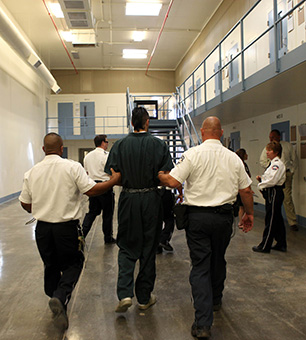Victoria Law
Truthout
December 6, 2013
 Danielle Rigney’s son was arrested and sentenced to six years in prison when he was 19. He spent two years imprisoned in California. Each weekend, family members or friends drove four hours to visit him. “He got to see his sisters growing up; he got to keep up with their lives,” she told Truthout. “We constantly talked about the future.” In addition to weekly visits, Rigney’s son also had a job in the prison and was on the waiting list for college classes and a technical training course.
Danielle Rigney’s son was arrested and sentenced to six years in prison when he was 19. He spent two years imprisoned in California. Each weekend, family members or friends drove four hours to visit him. “He got to see his sisters growing up; he got to keep up with their lives,” she told Truthout. “We constantly talked about the future.” In addition to weekly visits, Rigney’s son also had a job in the prison and was on the waiting list for college classes and a technical training course.
In July, however, Rigney arrived at the prison only to be told that her son had been transferred to La Palma Correctional Facility, one of two Arizona private prisons owned by Corrections Corporation of America (CCA). Now each visit requires round-trip plane tickets and costs Rigney’s family nearly $1,000. Neither his father nor his elderly grandfather, who were able to visit him regularly in California, can make the 15-hour trip. His friends, who also visited him regularly, also cannot afford to visit him.
Rigney is not the only Californian with an incarcerated loved one out of state, but she is one of the handful of family members able to afford to visit. “I’ve visited three times so far,” she said. “There have been, at most, ten other visitors when I’ve been there.” In comparison, she noted that the visiting rooms at the California prisons were full.
As of November 20, 2013, California housed 8,302 of its state prisoners in private prisons in Arizona, Mississippi and Oklahoma. It sends more prisoners out of state than Hawaii, Idaho and Vermont combined.
Why does California use private, out-of-state prisons?
In 2006, to alleviate prison crowding, then-Gov. Arnold Schwarzenegger signed an Emergency Proclamation authorizing California to transfer people to private, out-of-state prisons without their consent. By 2011, more than 10,000 California prisoners had been transferred to five private prisons.
That number still left California with an overcrowded state prison system. In 2011, in response to the class-action suit Plata v. Brown, the US Supreme Court ruled that California’s severely crowded prison system prevented it from providing adequate medical and mental health care to prisoners and that the state was in violation of the Eighth Amendment’s ban on cruel and unusual punishment. It ordered California to decrease its state prison population to 137.5 percent of capacity. In October, the court extended California’s deadline to comply until February 24, 2014.
This year, Brown revealed that the state’s plan to reduce crowding includes sending an additional 4,000 people to private prisons in and out of the state. California also will keep nearly 9,000 people out-of-state for another three years. In July 2013, the California Department of Corrections and Rehabilitation (CDCR) signed a three-year contract renewal with CCA, making 8,988 beds available in its prisons in Arizona, Mississippi and Oklahoma.
In September, however, a three-judge federal court ordered the Prison Law Office, which represents California prisoners in Plata, and the CDCR, participate in meet-and-confer discussions. These discussions are supposed to include:
- Reduced sentences (and possible release of) those sentenced under Three Strikes.
- Expediting the process of resentencing juveniles originally sentenced as adults.
- Paroling the elderly and the medically infirm.
- Sending non-citizen prisoners to Immigration and Customs Enforcement before the end of their sentences.
- Any other means to reduce prison crowding, including relocation within the state.
During this time, the court also ordered that California not enter into arrangements to lease additional capacity in out-of-state facilities or otherwise increase the number of people sent to out-of-state prisons. This does not prevent California from utilizing the 8,988 out-of-state prison beds for which it already has contracts. Bonnie Madrid, a prisoner-rights activist and member of advocacy group Californians United for a Responsible Budget (CURB), stated that she has been told by several prisoners that they are slated for transfers to a CCA-run prison in Arizona. According to the CDCR weekly population report, the number of people in out-of-state prisons rose from 8,267 on November 13th, to 8,302 the following week.
Problems with Out-of-State Private Prisons
In 2010, the office of the inspector general issued a report listing concerns about conditions inside these private prisons, including insufficient security procedures, an unapproved use-of-force policy, the discarding of prescribed medications that arrive with a newly transferred prisoner and prolonged placement in segregation. The report made little difference and California continued to send prisoners to private, out-of-state prisons.
In June 2013, Grassroots Leadership, an organization working to end for-profit incarceration, released The Dirty Thirty, a report chronicling CCA’s 30-year history of prisoner abuse, scandals, escapes, lawsuits and employee mistreatment. Although the report did not focus on the CCA prisons currently contracted by CDCR, it noted CCA’s campaign contributions to California lawmakers, including $234,500 in 2007 to 2008 alone and another $100,000 to then-Governor Schwarzenegger’s 2009 “Budget Reform Now” coalition. Six months later, the report notes, CDCR sent an additional 2,336 prisoners to CCA prisons, extending their contract “in a deal worth more than $54 million a year.”
In October 2011, a riot broke out at Oklahoma’s North Fork Correctional Facility, a CCA-run prison utilized by CDCR since 2007. The riot began with a fight in the dining hall then spread to other parts of the prison. Nearly 50 prisoners were injured; 16 required outside hospitalization, and four had to be taken to a nursing home to recover in a safe environment. Inquiries from alarmed family members in California were met with silence. “We had no idea who was injured. California Department of Corrections is notorious for not notifying families of injuries, and we were so worried,” one family member told The Oklahoman. “Until their letters arrived, about ten days later, none of us knew anything at all. The prison staff was not helpful in any way at all. We posted on Prison Talk desperately trying to get news.”
 Daily Stormer The Most Censored Publication in History
Daily Stormer The Most Censored Publication in History


